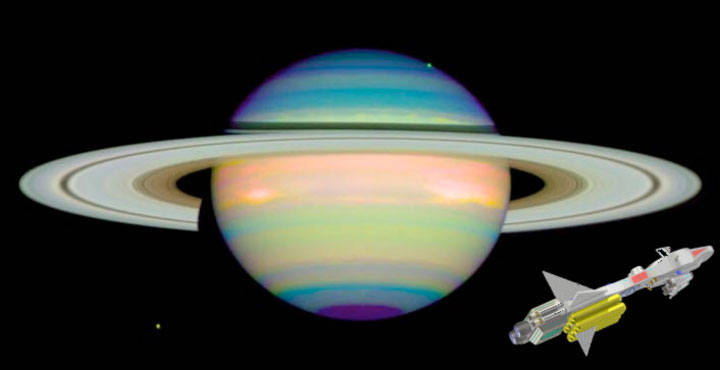 | |||||||
 |
|||||||







| |||||||
Core elements of the spaceship TRITONTRITON has a “hybrid propulsion system” at its disposal
|
|||||||
|
First Law: Under the natural law of this universe, nothing and no one imposes any restrictions on humankind, except itself. Second Law: The rightful field of humankind's activist is not only the earth, but the entire solar system and as much of the universe, as reachable under natural laws. Third Law: By expanding into the universe, humankind fulfils its destiny as the element of life – endowed with power, reasons and the wisdom of moral laws. |
These laws are the pillars of space travel, of the development of modern rocket technology (as well as other technologies) and our ambitious plans and hopes for the future. The following description sketches various main components of the TRITON-spaceship and outlines its functions relating thereto.
Storage space for space probes, rocket backpacks, space suits, as well as the “space-trucks”. The latter is a self-sufficient mini-orbiter, manned by two astronauts, for exterior operations in the asteroid belt, the Saturn ring and further objects of the solar system. Furthermore, the NA holds components of the gear used for the construction of the planned base stations on the red planet Mars, the Jupiter moon Callisto, the Saturn moons Titan, Iapetus etc., ranging until the distant and mysterious mini-planet Sedna.
Command structure and accommodation spaces
- The entire LS is self-rotating in order to produce a gravitational force of 0.7 g on board.
- Radiation isolation is achieved by a three metre (9.84 ft) thick coating of liquid hydrogen, which is collectively washing around the LS.
Further envisaged is a small biotope in one of the floors as an accommodation opportunity. The unit holds a continuous track (for sport, jogging) on its lowest level, which runs around the entire LS in a circular fashion. Adjoining is a fitness room.
In order to simulate the 24-hour day/night cycle ruling earth for the whole crew, the entire light- and also temperature-regulation is computer-operated, mainly to imitate the earthly rhythm of work, leisure and sleep cycle through light adjustments.
Crew composition: maximum total amount 60 astronauts, 12 robots
The approximately 40 metre (~131 ft) long middle part of the spaceship serves as storage space for all of the oxygen supply of the spaceship's crew, as well as all water and food stockpiles, the fuels for the lander, space-trucks and the breathing air bottles. In addition, the middle part stores 4 bottom part of the WEGA-landers. Since the two landing systems (bottom level 1), which are flange-mounted to the bottom of the spaceship, remain on the respective space object after the landing and return to the TRITON-mothership, the stored landing bottom parts are used for further landing manoeuvres by docking them to the returning lander-top parts. Hereby four additional landings are possible. Furthermore, there are three pieces of aerobraking shields installed on the bottom side of the CP. They serve as heat isolation to which the entire lander is “clipped on”, thereby guaranteeing a corresponding heat protection and effective deceleration when entering denser atmospherical layers. Their usage only occurs on planets and moons which have such a relevant atmosphere (Mars, Titan etc). An additional 3 pieces of shields can be mounted on the spaceship's upper surface.
All of the spaceship's manoeuvres are carried out by 4 steering engines overall. There are two steering nozzles located in the left and right side parts of the cylindrical command unit. In the case of these two pairs of nozzles being in a horizontal position relative to the spaceship's surface, the diametrical ignition of the steering nozzles running on chemical fuels, causes the spaceship to turn right or left. A conically arranged segment includes a rotary plate each on the joint plane, which ensures, by rotating 90°, that the dual engine set located on top of it enables, when ignited, the TRITON-spaceship to tilt and roll along its central axis, both clockwise and counter-clockwise.
The necessary manoeuvres to wheel the vessel in relation to its nose area (up / down) are made possible by the vertical adjustment of both engine pairs and simultaneous short impulse thrusts up and down.
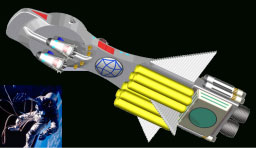
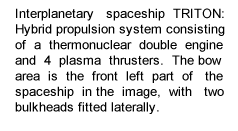
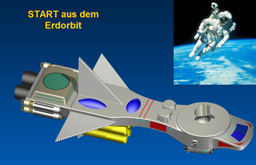

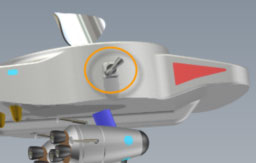
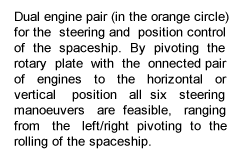
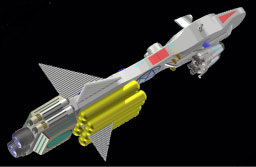
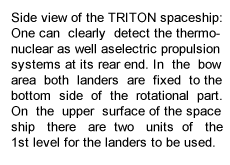
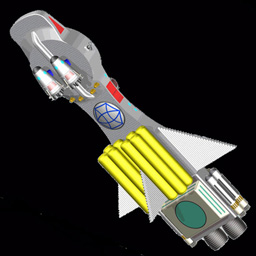

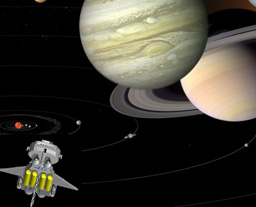
© Copyright 2018 - DI. Dr. techn. Joachim Achleitner Imprint
